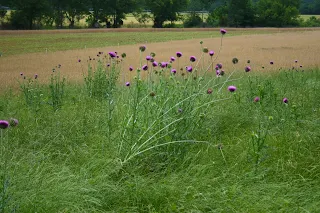Musk Thistle In Home Lawns and Gardens
What is Musk Thistle
Musk Thistle is a weed which mainly occurs on acreages and roadsides in various parts of the country due to their preference for sparse or degraded areas of soil. However, they can and do invade the home lawn as well, which most often occurs when a lawn has become degraded due to a current or previous drought, or perhaps lack of care by a previous owner.
For homeowners wanting to return their lawn to a state of good health and to be weed-free, they may also need to control and kill any infestations of Musk Thistle, which is a nasty, prickly weed which can re-produce in great numbers if not effectively controlled.
Musk Thistle Life Cycle
Musk Thistle is biennial, meaning its life cycle lasts over two years. It begins it's life as a seedling in spring and will turn into a rosette as the season continues. The rosette stage will last for the first season of its life and is recognizable by having many prickly leaves which spread out from its center, and which lay low to the ground.
After Musk Thistle over-winters in the rosette stage, it will emerge the next Spring and begins the next part of its growth by sending a vertical shoot up into the air which will eventually grow flowers. This stalk is often called a Bolt. At its maturity, Musk Thistle will produce several Bolts from each weed plant, each with a prickly stem containing a prickly pink flower at its head.
The pink flowers can produce up to 20,000 seeds per plant, so these weeds must be controlled as effectively and as soon as possible. Sometimes treatments for Musk Thistle may last for several years if there has been a prior infestation of seeds into the soil.
Controlling and Killing Musk Thistle
Musk Thistle only spreads and reproduces itself from its seeds. With this in mind, the greatest and easiest form of control is to never allow the Musk Thistle to create more seed heads that are formed from its flowers. This can be easily done by cutting off or mowing over the top of the bolts, and placing the waste into the bin.
If the weed is producing flowers and seeds, this means the weed is in its final year of growth and will die naturally, so there is very little else which needs to be done.
If it is noticed that there are Musk Thistle rosettes present, which are still in their first year of life, then a herbicide may be the best treatment method for the infestation. Herbicides are available for this weed, and the manufacturer's recommendations should always be followed for its use. The best time to apply these herbicides is in the Spring or Fall
If the infestation of rosettes is only small, then the easiest and most environmentally friendly way of killing Musk Thistle is to simply get a sharp knife and cut it off below its crown, which is the base of the plant, and the problem is solved.

